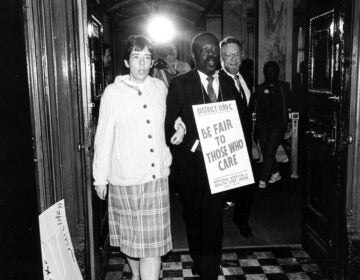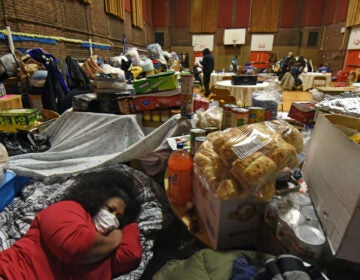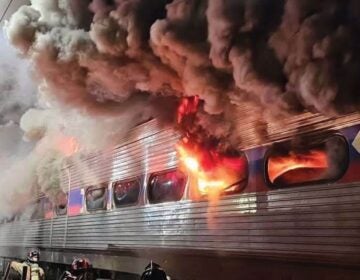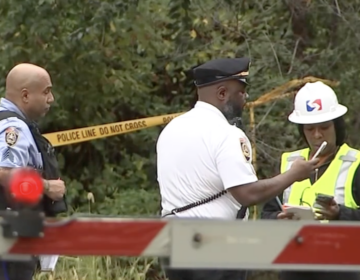Philly, PATCO respond to Center City transit station encampment with social services
People set up tents inside the underground concourse at 12th and Locust streets seeking warmth and shelter during the recent snow emergency.
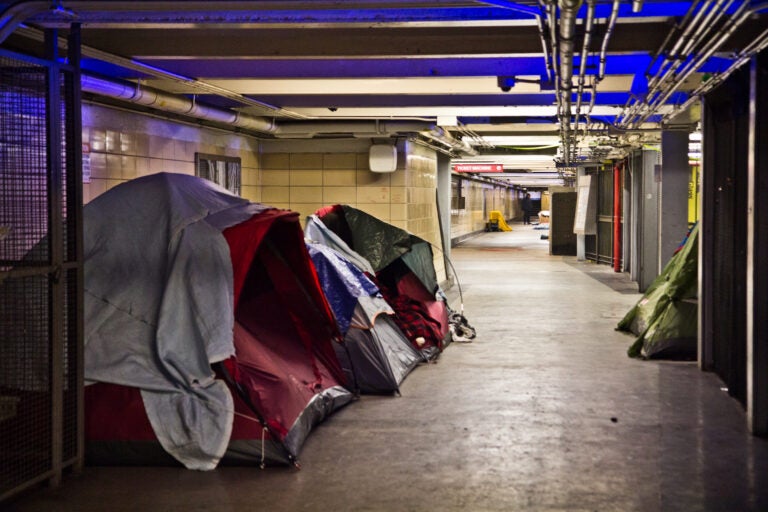
Tents and sleeping bags line the tunnels of the Locust Street Patco Station in Center City on Feb. 23, 2021. (Kimberly Paynter/WHYY)
An encampment of people living in tents inside a Center City PATCO station has brought Philadelphia’s housing problem into clear view.
People set up tents inside the underground concourse at 12th and Locust streets seeking warmth and shelter during the recent snow emergency and ongoing cold snap. But the encampment can’t be blamed on the weather, said Liz Hersh, Director of Homeless Services at the city’s Office of Homeless Services.
“We just don’t have enough places for people to live, it’s really that simple,” she said. “It’s a symptom of the deep poverty that we see, the deep inequity and the gap between rich and poor. We have a lot of people who are living on disability income, which is [around] $800 a month, or maybe they have no income at all, and they just can’t afford to pay the rent.”
The city owns the concourse and PATCO operates the transit station, so the two entities are working together to address the situation, officials said Tuesday.
“These are individuals who have fallen on very difficult times, and we are working with the city to provide them with assistance and resources,” Delaware River Port Authority spokesperson Mike Williams said.
Hersh said outreach workers are educating people at the encampment about other options such as emergency shelters, residential treatment programs, and mental health facilities known as safe havens. She said these facilities operate without barriers to entry — individuals don’t need IDs to enter.
She added that over the last three years, the city has seen an increase in encampments, even though the number of people living on the street has gone down. The PATCO station tents popped up after 2020’s months-long political negotiation between Mayor Jim Kenney and the organizers of two large encampments along the Benjamin Franklin Parkway and Ridge Avenue near Philadelphia Housing Authority’s headquarters. The encampments came in response to a long-brewing crisis compounded by the COVID-19 pandemic.
A ‘safe’ environment underground
Encampments became increasingly visible in cities around the country before the pandemic. COVID-19 may have driven more people into the informal residential colonies, Hersh said.
“Some people are fearful of coming into shelters because of COVID-19, although the facts don’t bear that out,” she said, pointing to an agency-reported infection rate of under 3% since the pandemic’s onset. “We’ve separated beds, added bed barriers, we do grab-and-go meals, mandatory masks, a lot of hand washing, education … so the shelters really have done a remarkable job of keeping people safe through social distancing.”
She said the rise of the encampments may be a symptom of something everyone should understand: a desire for community.
“Homeless people are like everybody else: They like to live in communities, they like to live with people whom they have things in common with and who they like, and so they live together,” Hersh said.
Through federal CARES Act funding, the city is now working to move some 75 people into a home via a rapid rehousing program that will allow them to live there for one to two years with subsidized support in the form of social services, she said.
Transit police experiment with social service approach
SEPTA doesn’t have a role with the 12th Street station encampment, but it is not uncommon to find people experiencing homelessness in agency stations, spokesperson Andrew Busch said.
“The train system is out of the elements, it’s a safe environment, … so we do have our own challenges … and they become a little more acute at this time of year due to the weather,” he said.
In addition to helping people obtain services offered by the Office of Homeless Services, Busch highlighted a SEPTA effort that partners transit police officers with social service professionals. Called “Serving a Vulnerable Entity,” the two-prong approach is designed to help in the treatment of people struggling with addiction and mental health disorders and de-escalate conflicts. SEPTA hopes to expand the effort.
“We know that policing by itself is not going to be the solution to this problem,” Busch said. “[The social service professionals] are able to sometimes break through the barriers that would exist.”
While the city, supplemented by nonprofit agencies dedicated to fighting Philadelphia’s homelessness crisis, has made progress, data shows that the Philadelphia region’s available affordable housing — 29 units for every 100 impoverished households — is far below the national average.
With the local economy reeling from the pandemic and the city’s budget deep in the red, Hersh says more federal funding has to be part of the equation.
“There’s no magic to addressing homelessness. It’s a totally solvable problem. When people have a place to live, they’re not homeless anymore. So it’s really a matter of making that investment in all of our people,” she said.
 WHYY is one of over 20 news organizations producing Broke in Philly, a collaborative reporting project on solutions to poverty and the city’s push towards economic justice. Follow us at @BrokeInPhilly.
WHYY is one of over 20 news organizations producing Broke in Philly, a collaborative reporting project on solutions to poverty and the city’s push towards economic justice. Follow us at @BrokeInPhilly.

Subscribe to PlanPhilly
WHYY is your source for fact-based, in-depth journalism and information. As a nonprofit organization, we rely on financial support from readers like you. Please give today.



